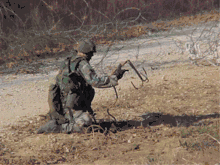Grappling hook
A grappling hook or grapnel is a device invented by the Romans in approximately 260 BC.[1][2] The grappling hook was originally used in naval warfare to catch ship rigging so that it could be boarded.[3] They typically have multiple hooks (known as claws or flukes), attached to a rope; it is thrown, dropped, sunk, projected, or fastened directly by hand to where at least one hook may catch and hold. Generally, grappling hooks are used to temporarily secure one end of a rope. They may also be used to dredge for submerged objects.

Design
A common design has a central shaft with a hole ("eye") at the shaft base to attach the rope, and three or four equally spaced hooks at the end, arranged so that at least one is likely to catch on some protuberance of the target. Some modern designs feature folding hooks to resist unwanted attachment. Most grappling hooks are thrown by hand, but some used in rescue work are propelled by compressed air (e.g., the Plumett AL-52), mortar, or a rocket.
Applications
Military
Grappling hooks are used by combat engineers to breach tactical obstacles. When used as such, the grappling hook is launched in front of an obstacle and dragged backwards to detonate trip-wire-fused land mines, and can be hooked on wire obstacles and pulled to set off booby traps on the wire. Two tools are available for this purpose; the rifle-launched grapnel, a single-use grappling hook placed on the end of an M4/M16 rifle,[4][5] or the crossbow launched version.[6] A grapnel can clear up to 99% of the trip-wires in a single pass.[7] During WW2 British and German ships would tow grappling hooks in the hope of snagging or damaging enemy submarines;[8] this was a tactic also employed by the Japanese.[9] Grappling hooks were used at the D-Day landings to aid soldiers climbing the cliffs at the Normandy beaches.[10]
Maritime
As well as the Grapnel Anchor grapnels are used in the removal and repair of subsea cables, large ships called Cable Layers drag huge grapnels across the seabed until they snag a cable.[11]
In popular culture
Video games
Grappling hooks, grapple guns and their many variants have been a staple in many video games since around the late 1980s. One of the earliest appearances in gaming is in 1987 arcade game Bionic Commando.[12] More recently they are a feature of the Dying Light, Uncharted, and Just Cause video game series. Link from The Legend of Zelda series famously utilizes a grappling hook, called a "hookshot".
See also
References
- "The Roman Navy and the Grappling Hook". Patent Pending. Retrieved 14 September 2019.
- "Naval Warfare". Britannica. Retrieved 14 September 2019.
- "Boarding Hooks". The Pirate King. Retrieved 14 September 2019.
- "The Launch Grapnel Hook (LGH), Infantry Magazine 1999 Sep-Dec pages 4-5" (PDF).
- "US5448937.pdf" (PDF). docs.google.com.
- "SAA International, Ltd". July 15, 2011. Archived from the original on July 15, 2011.
- Field Manual 3-34.2 Combined Arms Breaching Operations. 31 August 2000. Para. C-57 and Table C-2
- "A Brief History of Anti-Submarine Warfare". Globe Composite. Retrieved 14 September 2019.
- McDonald, Craig R. (2007). The USS Puffer in World War II: A History of the Submarine and Its Wartime Crew. p. 68. ISBN 9780786432097.
- "D-Day Landings in WWII Normandy". Classroom. Retrieved 14 September 2019.
- "Subsea Cables". Kis-Orca. Retrieved 15 September 2019.
- "30 years ago, Bionic Commando proved video game grappling hooks are awesome". Games.Avclub. Retrieved 15 September 2019.
External links
![]()